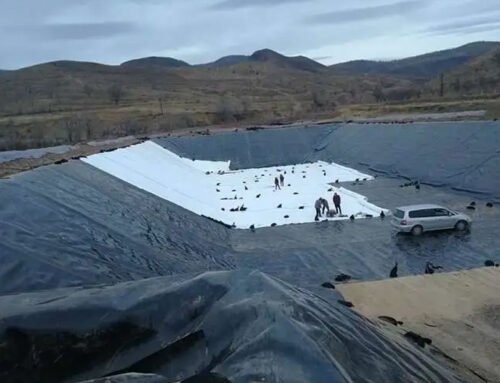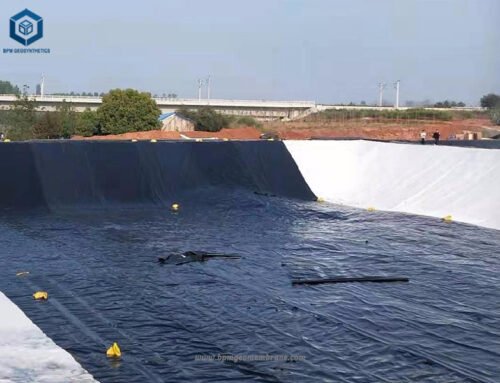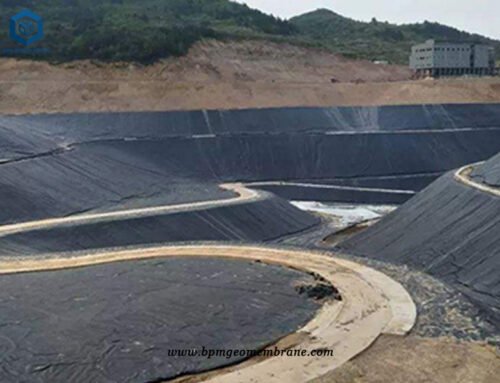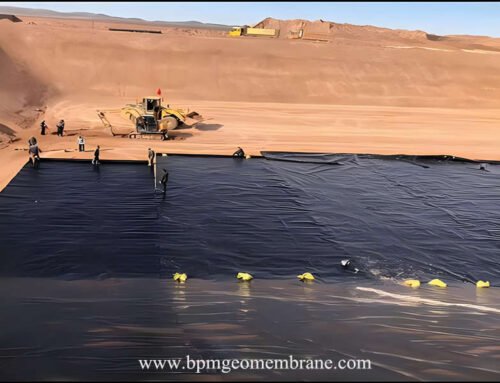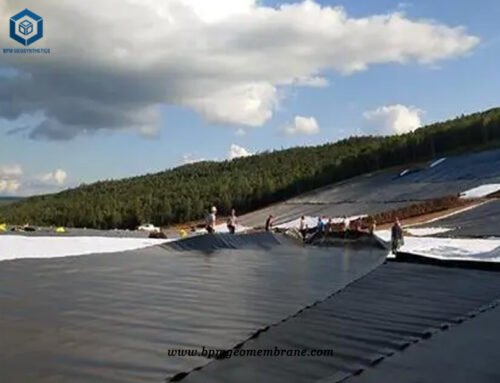Impermeable geomembrane is typically made from polyethylene which serve as water barriers in various applications requiring containment functions. Impermeable geomembrane is used in hydropower structures to prevent water seepage, while permeable geomembranes allow seepage water to pass through without displacing the soil. When an impermeable geomembrane is engineered with a textured surface, it is referred to as a textured geomembrane. On the other hand, when a geomembrane is combined with a geotextile, it is known as a geocomposite composite.
BPM Geomembrane offers a wide range of impermeable geomembrane liner in custom thickness and sizes at best factory price for your demands.
1. What Is Impermeable Geomembrane?
An impermeable geomembrane is a synthetic membrane made from high-density polyethylene (HDPE) raw material, enhanced with additives such as carbon black, antioxidants, anti-aging agents, and UV resistance components. It is designed to have extremely low permeability, high tensile strength, and a long service life. Impermeable geomembranes, like those manufactured by BPM Geosynthetics, are commonly used in biogas digester fields.
Geomembrane liners, also known as geomembranes, are impermeable membranes utilized in conjunction with rocks or soil to prevent the migration of fluids in man-made structures. These liners are typically made from various synthetic polymers, including EPDM, LLDPE, HDPE, PVC, and PP, and are available in sheets of varying thicknesses, ranging from 0.5 to 30 mm. or 20 mil to 120 mil. By blocking fluid movement, geomembranes effectively minimize the dispersion of contaminants and can be employed alongside soil liners or permeable geotextiles to create composite lining systems that offer enhanced security.
Geomembrane liners play a critical role in a wide range of applications, including environmental projects, mining operations, oil and gas facilities, and waste transportation industries. They provide reliable and durable barrier solutions, offering a variety of physical, mechanical, and chemical resistance properties to ensure optimal performance in diverse environments. Whether for primary or secondary containment purposes, geomembrane liners are essential for maintaining environmental integrity and safeguarding against fluid migration in various industries.
2. What Are The Functions of The Impermeable Geomembrane?
Impermeable geomembranes offer effective containment, protection, and management of water and waste resources. They play a crucial role in water conservation, environmental protection, and sustainable waste management practices.
2.1 Containment of Hazardous and Municipal Wastes
Impermeable geomembranes are used to secure landfills and waste containment facilities. They prevent the migration of hazardous substances and leachates into the surrounding environment, minimizing the risk of pollution and protecting groundwater resources.
2.2 Water Conservation
Geomembranes are highly impermeable, which means they effectively trap water and prevent its seepage. This property is beneficial in applications such as reservoirs, ponds, and irrigation systems, where water conservation is essential for sustainable water management.
2.3 Wastewater Containment
Geomembranes play a crucial role in containing and managing wastewater in various industries, including mining, agriculture, and wastewater treatment plants. They prevent the leakage and contamination of soil and groundwater, ensuring proper treatment and disposal of wastewater.
2.4 Landfill Protection
Impermeable geomembranes act as a barrier, preventing the migration of pollutants and leachates from landfills into the surrounding soil and water. This helps protect ecosystems, minimize the risk of environmental contamination, and ensure the long-term integrity of landfill structures.
2.5 Remediation Applications
Geomembranes are utilized in environmental remediation projects to contain and control contaminated soil or water. They isolate and prevent the spread of pollutants, facilitating effective remediation processes and protecting nearby environments.
2.6 Saltwater Intrusion Barrier
In coastal areas, impermeable geomembranes can be used as a barrier to prevent the intrusion of saltwater into freshwater sources. They help protect valuable freshwater resources and maintain the balance of aquatic ecosystems.
2.7 Durability
Geomembranes, depending on the material used, exhibit excellent durability and resistance to UV radiation, chemicals, and physical stress. This ensures their long-term performance and reliability in demanding environmental conditions.
2.8 Reduced Construction Efforts
Geomembranes can be prefabricated and easily installed, reducing construction time and efforts. Their flexibility and adaptability make them suitable for various site conditions, simplifying the installation process and minimizing disruptions.
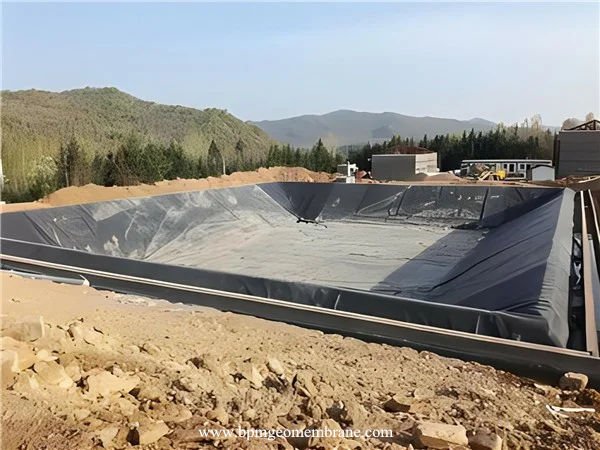

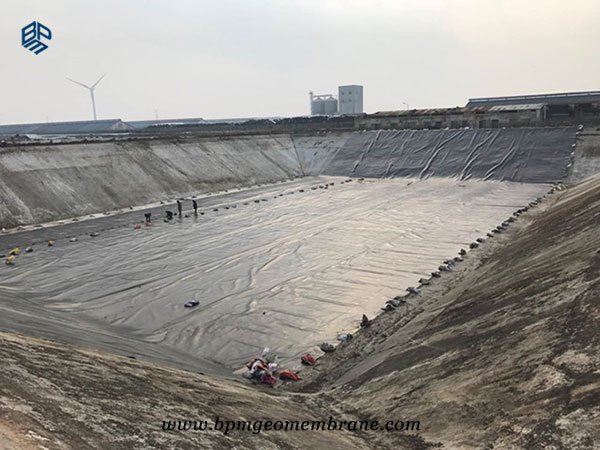
3. What Are The Benefits Of Impermeable Geomembrane for Biogas Digester Project?
Impermeable geomembranes offer benefits such as enhanced gas retention, environmental protection, longevity, cost-effectiveness, and sustainability in biogas digester projects. By incorporating these geomembranes, we can optimize biogas production, protect the environment, and contribute to the growth of clean energy solutions.
3.1 Gas Retention
Impermeable geomembranes, particularly those made from HDPE, effectively prevent the leakage of biogas. This ensures maximum gas retention within the digester, optimizing its collection and utilization for various energy applications, such as biogas power generation. This leads to increased energy efficiency and improved economic viability of the biogas plant.
3.2 Environmental Protection
The impermeable nature of geomembranes acts as a protective barrier, preventing the migration of harmful substances from the digester into the surrounding soil and water. This helps safeguard the environment, preventing contamination and minimizing the impact on ecosystems.
3.3 Longevity
HDPE geomembranes are highly durable and resistant to UV radiation, chemicals, and physical stress. They provide long-term protection and integrity to the biogas digester, ensuring its efficient operation over an extended period. This reduces the need for frequent repairs or replacements, resulting in cost savings and increased sustainability.
3.4 Cost-Effectiveness
By preventing biogas leakage, impermeable geomembranes minimize the loss of valuable gas and maximize the overall efficiency of the biogas plant. This leads to cost savings in terms of reduced gas wastage, increased energy production, and lower maintenance requirements. It enhances the economic viability of the project and improves the return on investment.
3.5 Sustainability
The use of impermeable geomembranes in biogas digesters promotes sustainable practices by effectively capturing and utilizing biogas, a renewable energy source. It contributes to the reduction of greenhouse gas emissions, dependence on fossil fuels, and overall environmental impact. By embracing HDPE geomembranes, we can take significant steps towards a greener and more sustainable world.
4. How to install Impermeable Geomembrane?
Installing an impermeable geomembrane typically involves the following steps:
4.1 Prepare the Site
Clear the area of debris, vegetation, and sharp objects that could potentially damage the geomembrane. Level the surface and remove any irregularities or protrusions.
4.2 Unroll the Geomembrane
Roll out the geomembrane smoothly across the designated area, ensuring complete coverage. Avoid dragging or pulling the geomembrane to prevent any tears or damage.
4.3 Secure the Geomembrane
Anchor the edges of the geomembrane using suitable methods such as trenching, anchoring strips, or batten bars. This prevents movement or displacement during installation and usage.
4.4 Seam the Geomembrane
If the area is larger than the width of the geomembrane, join multiple panels together using manufacturer-recommended techniques like heat-welding, solvent welding, or adhesive bonding. Ensure proper overlap and create a strong, waterproof seam.
4.5 Perform Weld Integrity Testing
Verify the strength and integrity of the seams by conducting weld integrity testing. This may involve visual inspection, air or vacuum testing, or other methods as per manufacturer instructions or relevant standards.
4.6 Use Anchor Trenches and Ballasting
Depending on the project requirements, employ anchor trenches or ballasting methods to further secure the geomembrane. These measures enhance stability and prevent uplift.
4.7 Install Penetrations and Transitions
For any penetrations through the geomembrane, such as pipes or cables, install appropriate sealing mechanisms like boots, flanges, or clamps to ensure a watertight seal. Similarly, properly seal transitions between the geomembrane and other structures, like walls or concrete, using compatible materials.
4.8 Conduct Quality Control and Inspection
Regularly check and inspect the installation to maintain quality control. Ensure the geomembrane is correctly installed, free from defects, and meets the required specifications.
5. Case Study of Impermeable Geomembrane Mexico For Biogas Digester Project
A case study in Mexico showcases the use of impermeable geomembrane in a biogas digester project. With the growing emphasis on utilizing waste for clean energy production, governments are actively promoting the construction of biogas digesters. In this context, BPM’s impermeable geomembrane proves to be an ideal solution due to its advantageous properties, including stress crack resistance, heat absorption, and chemical resistance. By incorporating impermeable geomembrane, the efficiency of biogas production is enhanced, leading to increased revenue through the sale of biogas to local government institutes or direct users.
The client in Mexico approached BPM with an inquiry for HDPE geomembrane liner for their large-scale biogas digester project. The dimensions of the pond were 65 meters by 120 meters. After careful consideration, we recommended using a 1.5mm impermeable geomembrane liner for the cover and a 1.25mm smooth geomembrane liner for the bottom of the digester. The total quantity of impermeable geomembrane required for the project was 18,000 square meters.
Over a span of 15 days, we engaged in professional communication with the client, addressing their specific requirements and concerns. As a result, they decided to proceed with the order, and we provided a comprehensive turnkey solution for the entire project. This included the impermeable geomembranes, geotextiles, welding machine, HDPE pipes and elbows, welding rods, and other necessary components.
Through effective collaboration and the use of impermeable geomembrane, the biogas digester project in Mexico was set on a path towards success. This case study exemplifies how the integration of impermeable geomembrane can contribute to the efficient and sustainable production of biogas, supporting the transition towards cleaner energy sources.
6. About BPM Geomembrane
BPM had provided many types of effective and states of the art geomembranes and other geosynthetics to over 36 countries. BPM is not only manufacturing best quality geomembrane products but also providing professional design and installation service. OEM, ODM, custom development and fabrication are also available. If you have any questions or inquiries, please fill and submit the following form, we will reply as soon as possible.

